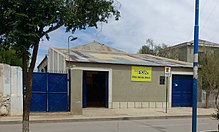Transportation in Bolivia
Bolivia is connected by road, rail, air and river networks. Access to ports at sea is also a vitally important issue for the Bolivian economy.
Terrestrial network
Road safety in Bolivia
Road safety in Bolivia refers to regulations, government and civil society actions that aim to protect the health of people who use public roads in that country, whether they are motorists, pedestrians, cyclists or motorcyclists and avoid traffic accidents. Among the planned actions are prevention campaigns, the evolution of traffic rules, their application and compliance.
As road safety is an element of public health, an important statistic is the number of deaths from traffic accidents. According to data from the National Traffic Department of the Police and the Inter-American Development Bank (IDB), on average there are 1,420 deaths each year due to car accidents.
In 2018, according to a calculation by the World Health Organization, Bolivia has the second highest mortality rate from traffic accidents in South America, with 23.2 deaths per 100,000 inhabitants.
To cover medical expenses, death and total and permanent disability in cases of traffic accident, in Bolivia there is the Compulsory Traffic Accident Insurance (SOAT), which is insurance that every vehicle must have.
Railway
Bolivia has a railway system divided into two networks
- La Eastern Network (FCO) with 1,244 km connecting to Brazil and Argentina.
- La Western Network (FCA) with 2,318 km in length that connects with Chile and Argentina.
Walking
With almost 70,000 km of roads and nearly 10,000 paved km (in 2010), since the rest is gravel or dirt, it also has a branch of the Pan-American highway that crosses the entire altiplano, thus connecting with neighboring countries. In Bolivia it is possible to summarize that only the cities of the Central Axis (La Paz, Cochabamba and Santa Cruz) and some other important cities, are integrated by paved road structures. In the rest of the territory there are dirt or gravel roads. But compensating for this deficiency, there is a complete network of national flights, connecting the different cities and more distant locations.
Air transportation
With more than fourteen international airports, the most important are:
- Viru Viru International Airport
- El Alto International Airport
- International Airport Jorge Wilstermann
Some of the companies are:
Nationals
- Boliviana de Aviación (BoA) (Nacionales)
- Amaszonas
- Ecojet
Foreign
- Airlines Argentinas
- LAN
- Gol Airlines
- TACA
- Lan Peru
- Avianca
- TAM Airlines
- Sky Airlines
- Copa Airlines
River network
With more than 14,000 km of navigable rivers and a series of seaports located in the various countries with which it has agreements such as Peru and Chile in the Pacific Ocean, Argentina, Brazil and Paraguay with the Paraguay-Paraná waterway with outlet to the Atlantic Ocean. It should be noted that in 2004 the Bolivian government emphasized the construction of a port to export abroad, Puerto Busch, on the Paraguay River. Further north in Puerto Suárez, Puerto Aguirre and Puerto Tamengo or Gravetal, (which are connected to the Paraguay River via the Tamengo Canal that crosses part of Brazil) medium-sized ships sail.
Since 2004, half of Bolivian exports have been dispatched through the Paraguay River. Upon completion of the construction of Puerto Busch, larger ships will be able to move cargo to and from Bolivia, which will increase competitiveness since it will not have to resort to foreign ports, mainly in Peru and Chile.
Ports
Pacific Ports
Arica and Antofagasta are ports enabled for the free transit of Bolivia, a country that so arranged when signing the Treaty of Peace and Friendship between Chile and Bolivia in 1904. The port of Iquique is in the process of being enabled. Almost 60% of Bolivia's foreign trade is carried out through the ports of northern Chile, with Arica being the main port of Bolivia's foreign trade.
Free ports
Bolivia also has free ports in Argentina, Paraguay and Uruguay, which are little used due to the lack of infrastructure.
- Puerto de Rosario in Argentina, in 1969 Bolivia is granted the use of this port and it is granted a free area of 54,667 m2 but is unused.
- Puerto Casado and Puerto Villeta in Paraguay, the 1938 Peace Treaty between Bolivia and Paraguay states that the latter guarantees free transit and free area.
- Port of Montevideo in Uruguay.
Contenido relacionado
Geography of Japan
Ruhr River
San Isidro District (Lima)





